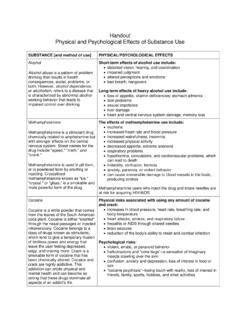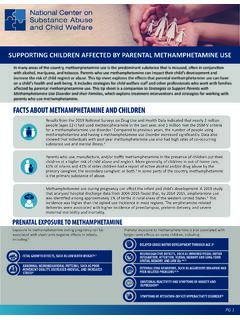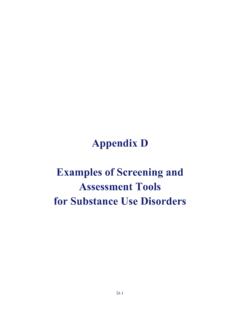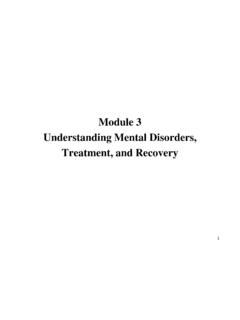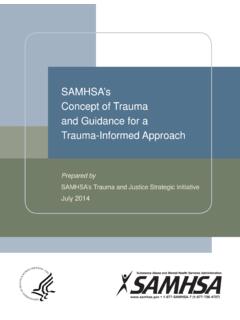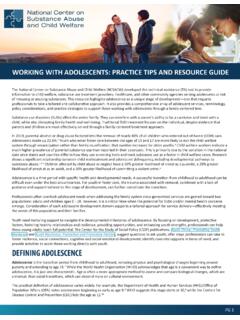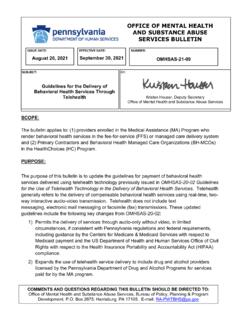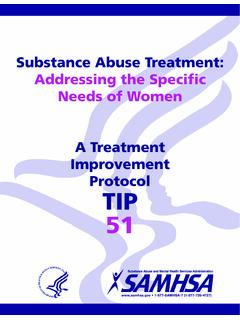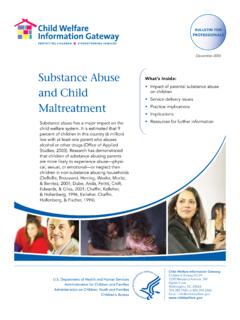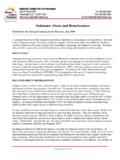Transcription of Understanding Substance Abuse and Facilitating Recovery
1 Understanding Substance Abuse and Facilitating Recovery : A Guide for Child Welfare Workers Understanding Substance Abuse and Facilitating Recovery : A Guide for Child Welfare Workers Acknowledgments This document was prepared by the National Center on Substance Abuse and Child Welfare (NCSACW). under Contract No. 270 027108 for the Substance Abuse and Mental Health services Administration (SAMHSA) and the Administration for Children and Families (ACF), both within the Department of Health and Human services (HHS). Elizabeth M. Breshears, , , developed the document with assistance from Shaila Yeh , and Nancy K. Young, Sharon Amatetti, , served as the government project officer from SAMHSA (CSAT); Irene Bocella, , served as the project officer from ACF. Disclaimer The views and opinions expressed in this publication are those of the author and do not necessarily reflect the views, opinions, or policies of SAMHSA, ACF, or HHS. Resources listed in this document are not all inclusive; inclusion as a resource does not constitute an endorsement by SAMHSA, ACF, or HHS.
2 Public Domain Notice All material appearing in this document is in the public domain and may be reproduced or copied without the permission of SAMHSA, ACF, or HHS. Citation of the source is appreciated. However, this publication may not be reproduced or distributed for a fee without the specific, written authorization of the Office of Communications, SAMHSA, HHS. Electronic Access and Copies of Publication This publication may be downloaded or ordered at Or, please call SAMHSA's Health Information Network at 1 877 SAMHSA 7 (1 877 726 4727) (English and Espa ol). In addition, this publication can be ordered from the Child Welfare Information Gateway at 1 800 394 3366. Recommended Citation Breshears, , Yeh, S. & Young, Understanding Substance Abuse and Facilitating Recovery : A. Guide for Child Welfare Workers. Department of Health and Human services . Rockville, MD: Substance Abuse and Mental Health services Administration, 2009. Originating Office Office of Program Analysis and Coordination, Center for Substance Abuse Treatment, Substance Abuse and Mental Health services Administration, 1 Choke Cherry Road, Rockville, MD 20857.
3 HHS Publication No. (SMA) 05 3981. Printed 2005. Reprinted 2006 and 2009. Contents Introduction .. 1. Understanding Addiction .. 2. Alcohol Abuse and 2. Women and Substance 4. Co occurring Substance Abuse and dependence and mental illness .. 5. Determining an alcohol or drug connection to child welfare .. 5. Impact of parents' Substance Abuse on children .. 8. How to talk to children about parental Substance use .. 8. Cultural and ethnic sensitivity .. 9. Co dependence .. 9. Substance Abuse Treatment: Developing and Implementing a Plan for Management of a Lifelong 11. What is treatment? .. 11. What is Recovery ? .. 13. Treatment and Recovery issues specific to women .. 13. How effective is treatment and Recovery ? .. 14. Self help or 12 step groups .. 15. Interventions for Substance using, but non addicted 15. How to Motivate Parents into Treatment and Enhance Treatment Readiness .. 16. Readiness for change .. 16. Motivation to change .. 17. How to Support and Facilitate Recovery and Enhance Treatment Effectiveness.
4 19. Relapse and relapse prevention .. 19. Self help groups and Recovery .. 20. Culture as a factor in 20. Supporting Recovery for 20. Ways to Facilitate Cross System Communication and Collaboration .. 22. Why should I partner with local treatment programs? .. 22. Why should the Substance Abuse agency partner with me? .. 22. How do I partner with my Substance Abuse colleagues? .. 23. What issues and services should be included in the collaboration? .. 24. How to increase the chance of a successful 26. Resources .. 27. Federal resources: .. 27. Other resources: .. 28. Endnotes .. 30. Introduction The Abuse and neglect of children are a serious social issue in the United States. During 2002, each day, an average of 2,454 children were found to be victims of Abuse or During that same year, 532,000 children lived in foster homes because they could not safely remain in their own One of the major reasons children enter foster care is Abuse or neglect associated with parental alcohol or , drug 4.
5 Most states identify The Abuse of alcohol and drugs is considered a serious risk factor for child Substance Abuse as one Whether the Substance Abuse is by a parent or by another adult of the top two factors in caregiver in the home, the behaviors of adults while under the influence child Abuse and of alcohol or drugs can have life long effects on children. As a consequence, it is important for child welfare workers to recognize when alcohol or drug Abuse is a factor in the case of child Abuse or neglect; to help parents obtain appropriate treatment; and to understand the concept of Recovery in the context of child safety. A working knowledge of alcohol and drug services can help child welfare workers meet the Adoption and Safe Families Act timelines and fulfill the child welfare commitment to child safety, permanency, and well being. The Adoption and Safe Families Act requires a permanency plan within 12 months after a child enters foster care and requires states to initiate proceedings to terminate parental rights if a child has been in foster care for 15 of the most recent 22 months.
6 While 12 or 15 months is a long time in the life of a child, it is a relatively short time in the Recovery process of a parent with years, or even decades, of alcohol and/or drug Abuse . It is critical that the 15 month time period be well spent, and that when Substance Abuse is an issue, the parent's treatment needs be assessed and appropriate alcohol and drug services accessed without delay. To be effective, child welfare workers must understand Substance use disorders. Workers should always screen for Substance Abuse and feel comfortable asking questions on a routine basis about Substance use, Abuse , treatment, and Recovery while the case is open. To help accomplish permanency for children, child welfare workers need to partner with local alcohol and drug Abuse professionals and programs. An effective partnership between the child welfare and the alcohol and drug treatment systems can help parents with Substance use disorders retain or regain a parental role with their child, while not putting the child at risk of harm.
7 Thus, the child welfare alcohol and drug services partnership becomes a cornerstone for long term child protection, a key issue for child welfare workers. The purpose of this guide is to help child welfare workers: Understand the relationship of alcohol and drugs to child welfare, and recognize when Substance use is a factor in cases;. Understand addiction and how to support and facilitate treatment and Recovery ;. Enhance collaboration with Substance Abuse treatment partners; and, Improve outcomes for children of parents with Substance use disorders. The National Center on Substance Abuse and Child Welfare offers online training courses for child welfare workers available at 1. Understanding Addiction Alcohol and drug use occur along a continuum. Not everyone who uses substances is addicted. Levels of use generally are identified as use, Abuse , and dependence. Child welfare workers will want to determine whether or not alcohol or drugs may be a factor in the reported Abuse or neglect.
8 If Substance use is a factor in the Abuse or neglect, an assessment should be conducted to determine a parent's status on the use, Abuse , dependence continuum. Addiction to alcohol and drugs may be physical or What is physical dependence? psychological. Physical dependence refers to physical changes in the body, such as tolerance or withdrawal. The Physical dependence refers to symptoms of physical dependence vary by type of drug physical changes in the body, such as used. Psychological dependence refers to the perceived tolerance or withdrawal. The need for the alcohol and drugs to feel good, function, or to symptoms of physical dependence keep from feeling bad. Parents who use substances may use vary by type of drug used. alcohol only, one drug only, a combination of drugs, or a combination of alcohol and drugs. Poly drug use (more than What is psychological dependence? one drug, or alcohol and drugs combined) is a common pattern of use among Substance abusers. Psychological dependence refers to the perceived need for the alcohol Alcohol Abuse and dependence and drugs to feel good, function, or to keep from feeling bad.
9 In many States, the number of people treated for alcohol problems equals the number treated for all drugs combined. What is addiction? The amount of alcohol consumed and symptoms of dependence are discussed below and should be considered Alcohol and drug addiction are in child safety and risk assessments. It is important to stress diseases that, while treatable, are that, even when alcohol use is below the level that suggests chronic and dependence, the child welfare worker should assess parental alcohol use or Abuse as an indicator of risk to What does this mean? children. 8. This means that over time, the disease of addiction causes changes in How much is too much? the person's body, mind, and A child welfare worker should be concerned about the risk behavior, and that a person is unable of alcohol addiction if a woman drinks more than seven to control his or her Substance use, drinks a week or three drinks at a time. For men, the level is 14 drinks per week, or four per The American despite the harm that Psychological Association, Diagnostic and Statistical Manual Chronic and relapsing mean that the of Mental Disorders, 4th Edition, Text Revision (DSM IV/DSM.)
10 Addiction is never cured, and that IV TR) gives the definitions of Substance Abuse and Substance use may persist or dependence found on the following page. reappear over the course of an individual's life. 2. Implications for Child Welfare/ Examples of Risk Alcohol and Drug Use Continuum to Children Use of alcohol or drugs to socialize and feel effects; use Use during pregnancy can harm the fetus may not appear abusive and may not lead to Use of prescription pain medication per the dependence, however the circumstances under which a instructions from a prescribing physician can parent uses can put children at risk of harm sometimes have unintended or unexpected effects . a parent caring for children may find that he or she is more drowsy than expected and cannot respond to the needs of children in his or her care Abuse of alcohol or drugs includes at least one of these Driving with children in the car while under the factors in the last 12 months: influence Children may be left in unsafe care with an Recurrent Substance use resulting in failure to inappropriate caretaker or unattended while fulfill obligations at work, home or school parent is partying Recurrent Substance use in situations that are Parent may neglect or sporadically address the physically hazardous children's needs for regular meals, clothing, and Recurrent Substance related legal problems cleanliness Continued Substance use despite having Even when the parent is in the home, the parent's persistent or recurrent social or interpersonal use may leave children unsupervised problems caused by or exacerbated by the Behavior toward children may be inconsistent, such Substance as a pattern of violence then remorse Dependence, also referred to as addiction, is a pattern Despite a clear danger to children, the parent may of use that results in three or more of the following engage in addiction related behaviors, such as symptoms in a 12 month period.
